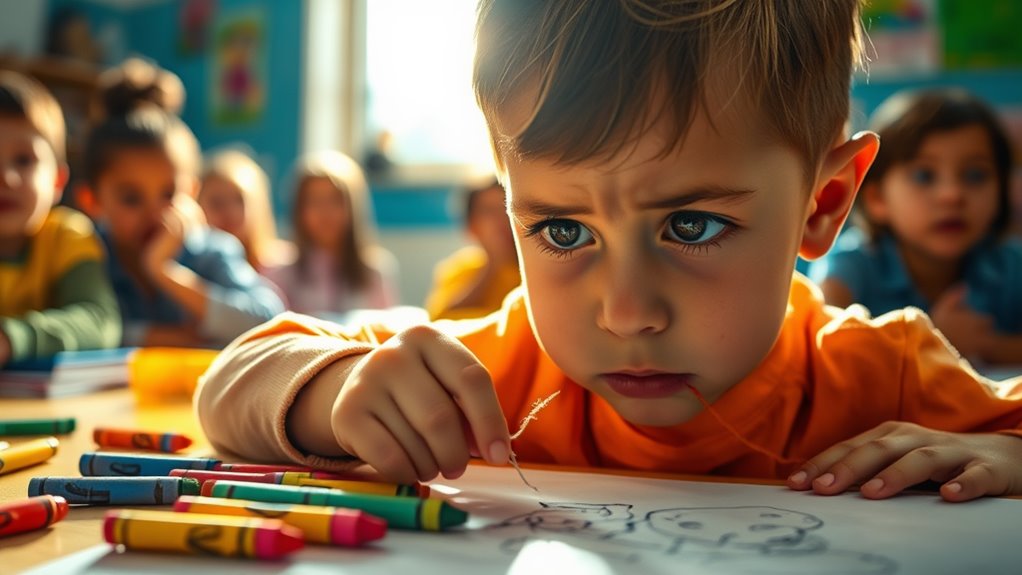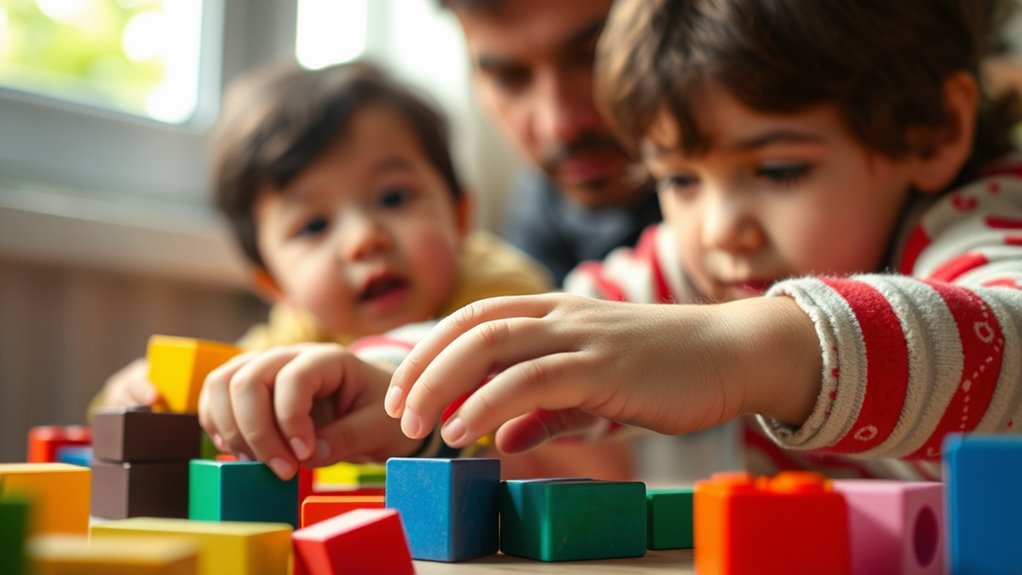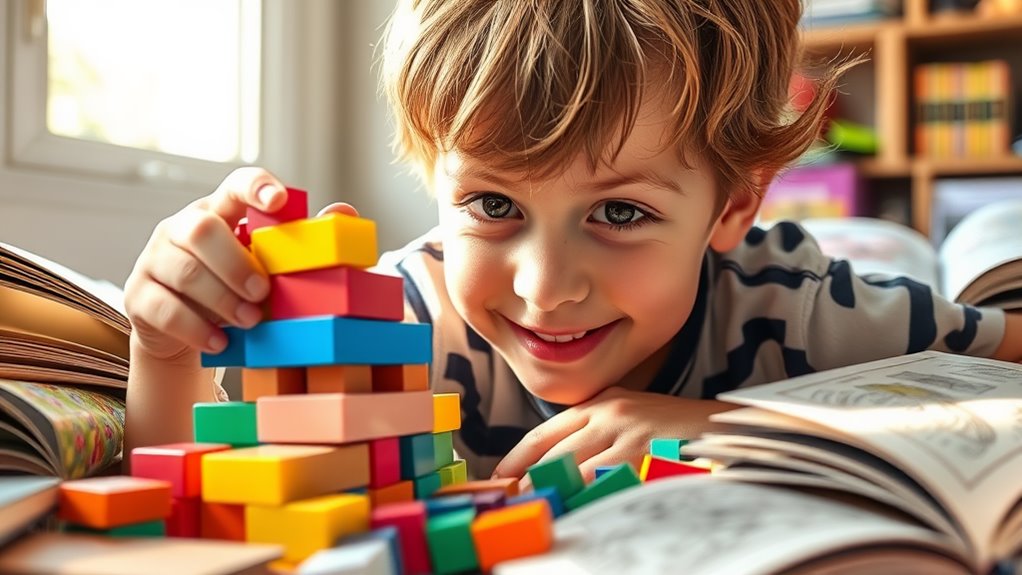How to Recognize the Early Signs of ADHD in Kids
To recognize early signs of ADHD in kids, look for common behaviors like difficulty focusing, frequent distractions, and impulsive actions. Your child might struggle to follow instructions or frequently zone out during conversations. Hyperactive signs include fidgeting, restlessness, or a preference for high-energy play. Emotional outbursts over minor issues could also indicate difficulties with emotional regulation. If you notice these behaviors consistently, it’s a good idea to seek professional guidance. Early intervention can make a significant difference. There’s more to understand about supporting your child effectively, so don’t hesitate to explore further resources available on this topic.
Key Takeaways
- Observe for inattentive behaviors like difficulty focusing, losing items, and being easily distracted during tasks or conversations.
- Look for impulsive actions such as interrupting conversations, blurting out answers, and difficulty waiting for turns.
- Note signs of hyperactivity, including fidgeting, restlessness, and a preference for high-energy play over quiet activities.
- Watch for emotional dysregulation, including intense mood swings and low frustration tolerance leading to tantrums over minor issues.
- Seek professional evaluation if consistent attention, hyperactivity, or emotional challenges are observed, as early intervention is crucial.
Common Behavioral Indicators
When it comes to recognizing early signs of ADHD in kids, certain behavioral indicators can stand out. One of the most common signs is inattentive behaviors. You might notice your child having difficulty focusing on tasks, frequently losing items, or appearing easily distracted. They may struggle to follow through on instructions, which can lead to unfinished homework or chores. These behaviors can create frustration for both you and your child.
Another significant indicator is impulsive actions. If your child often interrupts conversations, blurts out answers in class, or has trouble waiting their turn, these can be red flags. You might see them acting without thinking, resulting in risky situations or conflicts with peers. These impulsive tendencies can make it challenging for them to develop friendships or succeed in structured environments.
Recognizing these common behavioral indicators is essential for early intervention. By understanding these signs, you can take proactive steps to support your child’s needs, whether through professional evaluation or adjustments at home.
Being aware and observant can make a big difference in your child’s development and overall well-being.
Attention Challenges to Observe
In addition to the behavioral indicators mentioned, attention challenges are another key area to monitor. You might notice that your child struggles with maintaining their attention span during tasks or conversations. They may frequently zone out, even when you’re talking to them directly. This can be particularly evident in situations that require sustained focus, like homework or reading.
Pay attention to how often their focus shifts from one activity to another. If your child seems easily distracted by sounds or movements in their environment, it could be a sign of an underlying attention issue. You might find them starting a task, only to abandon it halfway through for something more stimulating or engaging.
These focus shifts can cause frustration, both for them and for you, as they may not finish important activities. Observing these attention challenges over time will help you understand if your child’s behavior is consistent and significant enough to warrant further evaluation.
Hyperactivity Symptoms in Children
Hyperactivity symptoms in children can manifest in various ways, making it important for parents to be vigilant. One of the most common signs is impulsive behavior. You might notice that your child struggles to wait their turn during games or frequently interrupts conversations. This impulsivity often leads to challenges in social situations, as they may act without thinking about the consequences.
Another key indicator is fidgeting tendencies. If your child constantly taps their feet, plays with their hair, or can’t seem to sit still during meals or class, these could be signs of hyperactivity. This restlessness often extends to difficulties in maintaining focus on tasks or activities, as they may feel the need to move around frequently.
It’s also important to observe whether your child has trouble engaging in quiet activities. If they seem to prefer high-energy play and struggle with calmer settings, this could further indicate hyperactivity.
Recognizing these symptoms early can help you guide your child towards appropriate strategies and support. If you suspect that hyperactivity is affecting their daily life, consulting a professional can provide valuable insights and recommendations.
Emotional Dysregulation Signs
Emotional dysregulation can be a significant indicator of ADHD in kids, often presenting as intense mood swings or difficulty managing feelings. You might notice that your child experiences emotional outbursts, reacting strongly to situations that seem minor to others. This can make daily interactions challenging, as they may struggle to control their emotions in the heat of the moment.
Another sign to watch for is low frustration tolerance. If your child gets upset easily when faced with obstacles or challenges, it could signal emotional dysregulation. You may see them throw tantrums over simple tasks, like homework or chores, because they feel overwhelmed or unable to cope with the stress.
Additionally, they’re likely to shift from happy to angry in seconds, leaving you confused about what just happened. These rapid changes in mood can disrupt family dynamics and create a sense of unpredictability in your home.
It’s essential to recognize these signs early, as understanding emotional dysregulation can help you support your child in developing healthier coping strategies and improving their emotional resilience.
Seeking Professional Guidance
Recognizing emotional dysregulation in your child can be the first step toward understanding their behavior and challenges. If you suspect ADHD, seeking professional guidance is crucial. A qualified mental health professional can provide a comprehensive evaluation, helping you determine if ADHD is the underlying issue.
They can also recommend effective therapeutic interventions tailored to your child’s specific needs. Don’t hesitate to reach out for help. Many professionals specialize in ADHD and can guide you through the process. They can offer strategies to manage symptoms and improve your child’s emotional regulation.
Additionally, they’ll be able to provide you with valuable parent resources that can help you navigate this journey. Understanding ADHD can feel overwhelming, but knowing that support is available can ease your worries.
Workshops, support groups, and informative websites can offer further insights and connect you with other parents who share similar experiences. Remember, you’re not alone in this. By seeking professional guidance, you’re taking an essential step toward ensuring your child receives the support they need to thrive.
Your proactive approach will help pave the way for a brighter future for your child.
Frequently Asked Questions
Can ADHD Symptoms Vary Between Boys and Girls?
Yes, ADHD symptoms can vary between boys and girls. Behavioral differences often stem from gender stereotypes, leading to boys displaying more hyperactivity, while girls might show inattentiveness, making diagnosis less obvious in female cases.
At What Age Can ADHD Be Diagnosed?
Did you know that about 5% of children meet the diagnostic criteria for ADHD by age 7? Early intervention can significantly improve outcomes, so it’s crucial to get a diagnosis as soon as signs appear.
Are There Genetic Factors Contributing to ADHD?
Yes, there’re genetic factors contributing to ADHD. If you have a family history of ADHD, it increases the likelihood of its presence in children. Researchers have found significant genetic links that suggest hereditary influences on the condition.
What Is the Difference Between ADHD and ADD?
Imagine a wild, buzzing bee versus a calm butterfly. ADHD often includes hyperactivity, while ADD focuses on inattention. Misconceptions abound, but understanding these characteristics can clarify the differences and help you navigate through them.
How Can Parents Support Their Child With ADHD at Home?
To support your child with ADHD at home, focus on behavior management strategies and use positive reinforcement. Create a structured environment, set clear expectations, and celebrate their successes to boost confidence and motivation.





